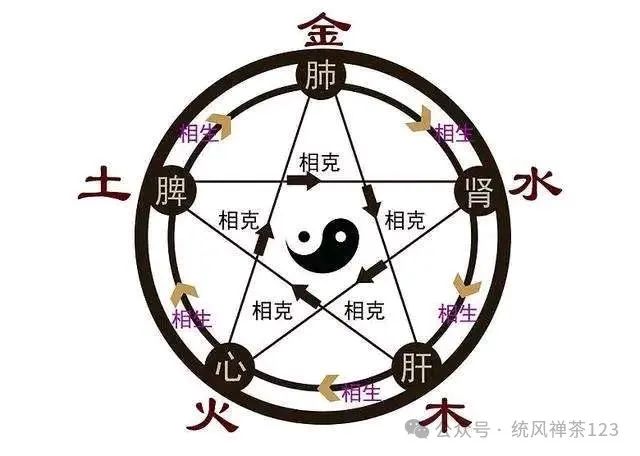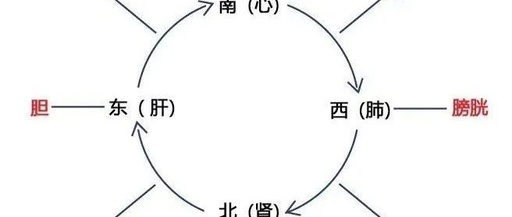TCM enthusiasts know that the five organs—Lung (Fei), Liver (Gan), Kidney (Shen), Heart (Xin), and Spleen (Pi)—are associated with the five elements: Metal, Wood, Water, Fire, and Earth. The functions of these organs are interrelated through the principles of generation and overcoming. When learning about TCM health preservation, one typically starts from this understanding of the body’s natural laws.

Today, we will not discuss the relationships between these organs but rather understand the functions of the human body as a whole. The health of the body is determined by the smooth circulation of Qi and blood, the harmonious functioning of the organs, and the cyclical movement of Qi and blood. If any organ’s function is imbalanced, the direction of treatment should focus on the circulation of Qi and blood rather than targeting a specific organ. For example, in cases of internal cold and dampness, many common practices involve moxibustion, fire therapy, cupping, or internal herbal remedies to dispel cold and dampness. While these methods may provide temporary relief, they often fail to produce lasting results and can even worsen the condition. Why is this? Consider the example of a thick ice layer on the Songhua River in mid-winter. If you build a fire on the ice, it may appear to melt slightly, but this is only a localized effect. Once the fire is gone, the ice returns, and may even become thicker! This analogy applies to the body’s cold condition. To resolve the ice layer, we must wait for spring, when a warm current rises from the ground to melt the ice from within. Similarly, if the body is cold, we must change the constitution. For instance, if there is excessive cold in the intestines, we must improve lung function, as the Metal element generates Water, which in turn can alleviate cold in the bones. The lungs govern the pathways of Qi! By improving lung function, we ensure a continuous cycle of inhalation and exhalation, facilitating the movement of Qi and blood, and promoting overall health. We should not treat a single organ in isolation; if one organ is problematic, we must simultaneously nourish the upstream and downstream organs, viewing the body as a whole to achieve balance among the five organs.
Below is a Daoist verse on balancing the five organs for us to study together:
Eight Trigrams Resolve
Balancing the Five Organs
The Changes of the Five Elements Are Boundless
Metal Wind Generates Water, Alleviating Bone Cold
Yang Water Generates Wood, Activating Earth
Wood Displays Divine Power, Fire Accompanies the Spirit
The Four Directions’ Waterways Are in the Lonely Spleen
Eight Directions Communicate, Initiating the Flow of Qi
Balancing the Five Elements
Explanation
Title: Balancing the Five Organs
Balancing the Five Organs: Observing from the outside to see the whole picture. (For example: the principle of the Twelve Meridians and the flow of Qi.) This refers to the functional principles of the body’s organs, which operate in a clockwise cyclical motion. Repairing a single organ requires restoring the overall functional cycle to enable automatic repair.
Summary: Regulating promotes circular motion, allowing organ functions to self-repair, achieving health preservation instead of relying solely on medical treatment.
Regulate: Adjust, nourish, repair, stimulate, activate.
1. The Changes of the Five Elements Are Boundless
Five Elements: Metal, Wood, Water, Fire, Earth—referring to the five organs and six bowels.
Changes: Each person’s functions vary over time; while individual constitutions differ, organ functions remain consistent and subject to change.
Boundless: Without limits, unpredictable changes.
2. Metal Wind Generates Water, Alleviating Bone Cold
Metal Wind: The lungs belong to Metal; Wind refers to Qi, ensuring the circulation of lung Qi.
Generates Water: The process of transformation; Water refers to the Metal element, which is nourished by Fire.
Bone Cold: In TCM, cold and dampness are categorized into five levels, with the most severe being in the bones, followed by the internal organs, tendons, meridians, and muscles.
3. Yang Water Generates Wood, Activating Earth
Yang Water: In the Kan hexagram, it belongs to Yin, representing Yin Water, which requires Yang. Only the balance of Yin and Yang Water can nourish the Kidney and subsequently promote Wood (Liver and Gallbladder).
Generates Wood: To provide nourishment and moisture to Wood (Liver and Gallbladder).
Activating Earth: To lead, initiate, and stimulate Earth, referring to the Spleen, which governs the transportation of Qi and initiates the flow of Qi in all directions. Nourishing the Spleen also emphasizes nourishing the Gallbladder, as the Qi of the Gallbladder leads to the elevation of Spleen Qi (Note: Nourishing the Gallbladder and Liver promotes downward blood flow; a healthy Liver supports a healthy Spleen, and a healthy Kidney nourishes Liver blood).
4. Wood Displays Divine Power, Fire Accompanies the Spirit
Wood Displays Divine Power: Wood represents the Liver and Gallbladder, which are Yin Wood and require Yang. Only through the transformation of Yin and Yang Wood can they flourish and exhibit their divine power.
Fire Accompanies the Spirit: Fire represents the Heart, which is associated with the Gallbladder Qi.
5. The Four Directions’ Waterways Are in the Lonely Spleen
The Four Directions: East, West, South, North correspond to the Liver, Lung, Heart, and Kidney.
Waterways: Water refers to essence, fluids, blood, and Qi, while pathways refer to the entire meridian system, including the twelve meridians and eight extraordinary vessels.
In: Centralized, the starting point.
Lonely Spleen: Independent, central axis (Note: The four directions are like four flywheels rotating around the central axis).
6. Eight Directions Communicate, Initiating the Flow of Qi
Eight Directions: The eight cardinal directions.
Communicate: Movement, connection, rotation.
Initiate: Start, repair, nourish, and protect.
Flow of Qi: The five organs have five winds; when the winds are smooth, the functions self-repair. Water refers to the twelve meridians and eight extraordinary vessels.
(Note: Summary: The circular motion operates in a clockwise cycle, resolving and repairing organ functions.)
7. Balancing the Five Elements
Balancing: From the outside, observing the whole.
Five Elements: Referring to the five organs.
Regulate: Nourish, protect, repair, and restart.
(Note: Summary: Imbalances in any organ stem from issues in circulation. Instead of targeting a single organ, we should focus on the overall circulation to achieve the effects of nourishment and repair. By restoring circular motion, we achieve balance, thus balancing the five organs.)
Viewing the whole to understand the parts, resolving local issues, and repairing the overall circulation is the true path to health preservation!


